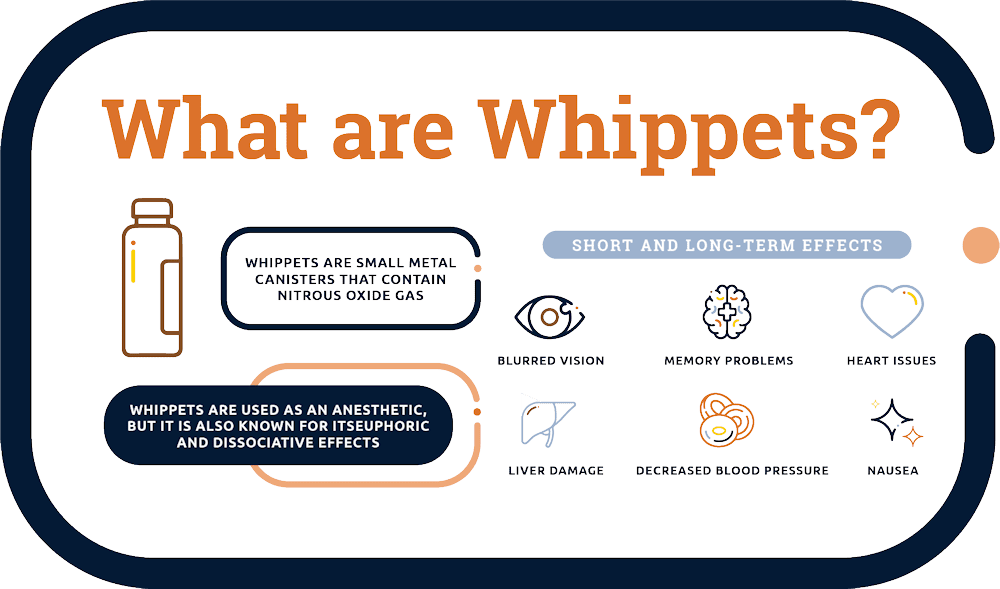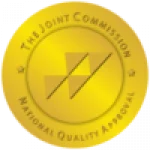Nitrous oxide has been safe and used medically for pain treatment for many years. But when someone uses it recreationally, it is known as whippits. Because nitrous oxide is a common ingredient in whipped cream, it’s legal and easy to obtain.
Some people believe whippits are safer than other inhalants. But, it can be very harmful. Whippit abuse can lead to long-term physical effects, addiction, and even death.
In medical settings, it is used as an anesthetic, while recreationally, it is often inhaled for its euphoric and dissociative effects. This happens because it slows down the brain and central nervous system.
While experts are still learning about how nitrous oxide affects the body, they do know:
- It lowers your ability to sense pain, sound, or touch
- It affects your emotional responses
- It causes you to feel lightheaded or hallucinate
- May cause delusions or false beliefs

How are Whippits Used?
Whippits are different from other inhalants because they take longer to become addicted to. One reason for this is how people get high and how the gas in whippits affects the brain.
When someone breathes in the gas from the metal canisters, it makes them feel light-headed because it reduces the amount of oxygen they get. It doesn’t give them a strong feeling of happiness as some drugs do, but it can make them feel less anxious.
The problem is the gas can affect how the brain works. The person using whippits can go without oxygen for short periods. People who abuse whippits may either breathe in the gas directly from the canisters or use special tools called crackers to open the canisters and breathe in the gas.
Some people find it easier to use balloons because they can get more gas than from the canisters. They would put the balloon in their mouth and breathe in the gas to get the same effects as the other methods of using whippits.
The effects of whippits can differ depending on previous drug use, how much gas they have breathed in. if they have mixed it with other drugs, and how often they have used whippits.
What are the Long and Short-term Effects of Whippit Abuse?
- Giddiness
- Uncontrollable laughter
- Seizures
- Moodiness
- Confusion
- Slurred speech
- Poor coordination
- Blurred vision
- Numbness
- Dizziness
- Sweating
- Decrease in blood pressure
- Nausea and vomiting
Long-term effects of whippit abuse include:
- liver and kidney damage
- heart dysfunction
- memory problems
- Fainting
- Numbness
- weakened immune system
- Paranoia
- dead brain cells (apoptosis)
- depletion of vitamin B12
- muscle spasms
- Addiction
Whippit abuse can also lead to nerve damage due to vitamin B12 depletion, resulting in hypoxia (lack of oxygen) overdose. Combining whippits with alcohol or other drugs can increase confusion and disorientation.
Can B12 Help Treat Long-Term Effects of Whippit Abuse?
- Weakness
- Balance problems
- Numbness and tingling sensations
- Memory problems
- Mood changes, paranoia, and delusions
Fortunately, there are effective ways to address these side effects of whippit abuse. A vitamin B12 supplement can help alleviate these effects during recovery.
Incorporating this supplement into your inhalant abuse treatment can assist in preventing the onset of additional problems for your mind and body as you progress in your recovery.
What are Signs of Whippit Abuse?
- Presence of empty canisters, steel cartridges, or cracking paraphernalia used to inhale nitrous oxide
- Physical symptoms such as a runny nose, red eyes, loss of appetite, sores around the mouth, or looking intoxicated
- Behavioral changes like mood swings, increased irritability, or unexplained changes in coordination and motor skills
- Neglecting responsibilities
- Withdrawing from relationships and social activities
- Financial struggles
- Being secretive
- Dependence or addiction causing cravings and making it hard to stop using.
While these are signs of whippit abuse, the presence of these signs does not definitively indicate whippit abuse. However, they can suggest that someone may be misusing or addicted to whippits.
If you suspect someone is abusing whippits, it’s crucial to encourage them to seek professional help and support.
Why Do Whippits Affect People Differently?
- Each person’s body and brain chemistry is unique. This means their response to whippit abuse can differ. Some individuals may exhibit more noticeable physical or behavioral signs, while others may show fewer overt symptoms.
- The frequency and duration of use can influence the signs of whippit abuse. Regular and prolonged abuse of whippits may result in more pronounced and consistent symptoms, while occasional or sporadic use may lead to less obvious indicators.
- The amount of nitrous oxide inhaled and the method of administration can impact the signs of abuse. Higher doses or combining whippits with other substances can intensify the effects and potentially manifest in more severe symptoms.
- With continued use, individuals may develop tolerance to whippits, requiring higher amounts to achieve the desired effects. Dependence can also develop, leading to more signs of addiction and withdrawal symptoms when attempting to stop using.
- If individuals combine whippits with other substances like alcohol or drugs, the signs of abuse can be influenced by the interactions and effects between the substances. This can result in a broader range of symptoms and complications.
Are Whippits, Whippets, and Whip-Its the Same Thing?
Nitrous oxide is classified as an inhalant. It’s a type of drug that can be easily obtained and is commonly found in households, as stated by the National Institute on Drug Abuse.
A popular way of inhaling whippits involves using whipped cream dispensers. However, directly inhaling the gas from the canister can be challenging and may cause frostbite. As a solution, people often release the gas into a balloon. The gas is warmed up, making it easier to inhale.
10 Facts about Whippits
- Whippits, when misused, can lead to oxygen deprivation or hypoxia. Inhaling nitrous oxide directly from the canister or in excessive amounts can limit oxygen intake and result in serious health risks.
- Oxygen deprivation caused by whippit use can lead to loss of consciousness, dizziness, and potentially life-threatening complications such as asphyxiation or brain damage.
- Whippits are often combined with other substances, such as alcohol or drugs, which can compound the risks and increase the likelihood of adverse effects.
- Chronic and excessive use of whippits can lead to addiction, with individuals developing a strong psychological and physical dependence on the substance.
- Regular use of whippits can cause vitamin B12 deficiency and result in neurological complications, including nerve damage and numbness in extremities.
- Whippit abuse can impair judgment and decision-making abilities, increasing the likelihood of engaging in risky behaviors or accidents.
- Inhaling nitrous oxide directly from the canister poses the risk of frostbite or cold burns to the skin and mucous membranes due to the extremely cold temperature of the gas.
- Whippit misuse can lead to respiratory problems such as lung damage or bronchospasms, especially when inhaled rapidly or in high concentrations.
- People with certain medical conditions, such as asthma or heart problems, are at higher risk of experiencing severe complications or adverse reactions from whippit use.
- Whippit abuse is associated with various potential short-term and long-term side effects, including nausea, headaches, confusion, fatigue, and memory impairment. Continued and excessive use can exacerbate these effects and deteriorate overall health.
Northern Illinois Recovery Offers Treatments for People Struggling with Inhalent/Whippit Addiction
- Individual therapy
- Behavioral therapies
- Group therapy
- Family therapy
- Gender-specific therapy
- Yoga and other holistic therapies
If you or someone you love is struggling with an addiction to whippits or other inhalants, it is time to get help. Contact us today to find out how we can get you on the road to recovery.



